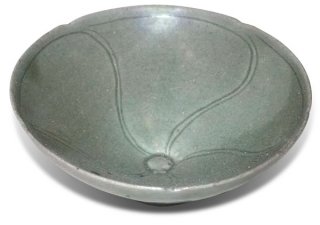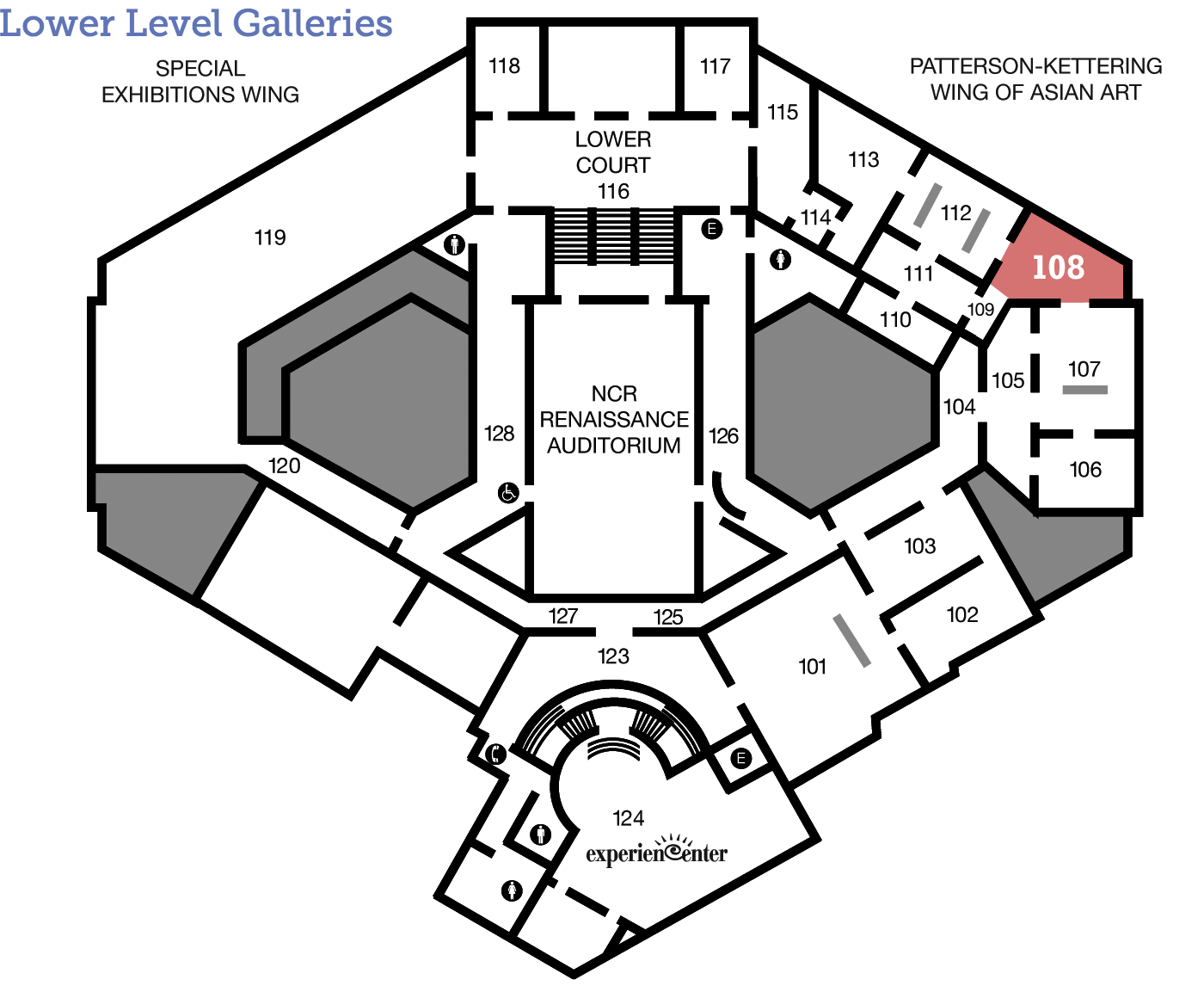
Korean
Tea Bowl
Korean Porcelain, incised design under celadon glaze Height: 4 ¼ inches Gift of Mrs. Virginia Kettering 1976.167
Hidden Depths
What do you see in this bowl? A mysterious color? A great dynasty of Korean history? One of the most treasured kinds of pottery in the world? Take a closer look; it may contain more than you think.
A Day in the Life
The Flowering of Korean Culture
The Goryeo dynasty (918–1392) was a time of artistic accomplishment, particularly celadon ceramics. In fact, the word goryeo means “refined elegance.” (It is also the basis for the English name “Korea.”) There were also significant religious, political, and technological developments during this period. Select the words below to discover more about each.
Religion
The Goryeo court commissioned a complete edition of the Buddhist canon (Tripitaka) consisting of over 80,000 woodblock prints. This was made in response to the Mongolian invasions in the 1200s, which ravaged the country and forced the court to flee to the nearby island of Kanghwa. The project served to invoke divine protection and replace an earlier set destroyed by the Mongols in 1232.
Politics
The ruler Wang Kon (ruled 918–943) largely unified Korea, bringing together the three kingdoms of Silla (southeast), Paekche (southwest) and Koguryo (north) that had disintegrated after the somewhat-unified Silla dynasty (668–935). This marked the emergence of the Goryeo dynasty.
Technology
A metal, moveable type for printing texts was developed in the early 1200s. This supported the literary education of the elite, particularly for the state-sponsored examinations that were required for civil service jobs.
Further Reading: Jonathan W. Best, “Context of the Artistry: A View of the Korean Past,” in The Radiance of Jade and the Clarity of Water: Korean Ceramics from the Ataka Collection, organized by Ikutarō Itoh and Yutaka Mino (Chicago: The Art Institute of Chicago, 1991), 15–26 and Edward Scultz, “Cultural History of Goryeo,” in Goryeo Dynasty: Korea’s Age of Enlightenment, 918–1392, Kumja Paik Kim (San Francisco: Asian Art Museum of San Francisco, 2003), 23–31.
Tools and Techniques
Making the Old New
Korean celadon objects from the Goryeo dynasty (918–1392) are some of most treasured ceramics in the world. They are called “celadon” because of their unique grey-green celadon glaze (see “Look Closer”). What makes them so special? How are modern Korean potters reviving this craft? Find out more in the following video from the Asian Art Museum.
© Copyright Asian Art Museum Chong-Moon Lee Center for Asian Art and Culture, 2003
Transcript Summary:
The production of celadon ceramics thrived during the Goryeo dynasty, especially in the southwest of the Korean peninsula, where there was abundant clay, water, trees, and sea transportation routes. Although celadon originally came from China, Goryeo celadon quickly became famous for its unique color and decoration. Xu Jing, a 12th-century Chinese envoy, described Goryeo celadon as having “the radiance of jade and the clarity of water.”
In 1997 a museum dedicated to Goryeo celadon ceramics opened in the city of Gangjin in the southwest corner of South Korea. This museum studies, preserves, and exhibits celadon vessels, and hosts an outdoor festival. There are also demonstrations of the techniques involved in producing celadon. The most famous kind of decoration is the inlay technique known as sanggam. White and red clay slip is brushed into designs that have been incised into the clay (after firing the red slip will appear black). Celadon are fired twice. The first firing is about 800 degrees centigrade. Then the glaze is applied. The unique color of Goryeo celadon derives, in part, from a small amount of iron in the glaze. The glazed vessels are put back in the kiln, but this time in containers that protect them from debris in the firing process. The second firing is about 1300 degrees centigrade, and oxygen is removed from the atmosphere inside. These various steps help produce the the unique bluish grey-green color of Goryeo celadon and its subtle variations. Many potters in Korea think that the celadon made today is about 90% the same as that made during the Goryeo dynasty. The thousand-year-old tradition of Goryeo celadon is being revived in both traditional and modern forms, allowing it to become a part of people’s daily lives again.
Behind the Scenes
Look Closer
The Play of Light
Look closer at the glaze on this bowl. It is a kind of glaze known as celadon. Celadon contains iron oxide and produces a range of colors when it is fired in a kiln with reduced oxygen. Ceramics with celadon glazes from Korea during the Goryeo dynasty have a unique green-grey color, which comes from a combination of iron oxide (green) and manganese oxide (grey) in the glaze.
Goryeo celadon is also famous for its rich, translucent appearance. What creates this visual effect? If you looked closer with a microscope you would see there are a mix of particles that scatter and absorb light. Black magnetite particles absorb light, creating subtle darker areas. White quartz and quartzite particles bend and scatter light, increasing the path that light travels though the glaze. The play of light is further intensified by microscopic bubbles in the glaze, as well as craze lines, the little cracks that may appear on the surface. Craze lines are formed in the cooling process in the kiln when the glaze contracts quicker than the clay body. You can see craze lines more clearly on some of the other celadon pieces nearby.
Further Reading: Pamela B. Vandiver, “The Technology of Korean Celadons,” in The Radiance of Jade and the Clarity of Water: Korean Ceramics from the Ataka Collection, organized by Ikutarō Itoh and Yutaka Mino (Chicago: The Art Institute of Chicago, 1991), 151–158.
Just for Kids
Look!
This bowl was used for drinking tea during a tea ceremony. During your visit to the museum you may notice many kinds of vessels and bowls that are used for drinking tea, water, or even hot chocolate! Look around at these vessels. How are they the same? How are they different?
Signs & Symbols
Dig Deeper
Arts Intersected
The Sculpture Speaks
Did You Know?
Glossy Glazes and Jet Planes
The same property of volcanic ash that makes it a threat to jet planes is the same property of ash in ceramic glazes that causes them to become glossy when fired at a high temperature. Silica in ash changes to a glass-like substance in high heat. A hot plane engine can melt the ash and fuse it to engine parts, deteriorating surface coatings or even jamming the engine.
Expert Opinion
Look Around
About the Artist
Talk Back
Bigger is Not Always Better
This bowl is small and simple, compared to the other Korean celadon vessels nearby. As you look at it closely, what features set it apart and give it a charm all its own?

